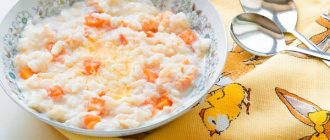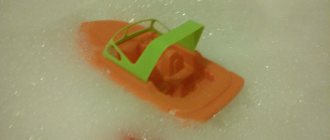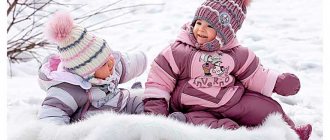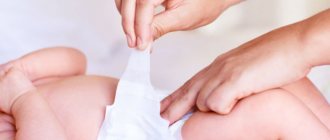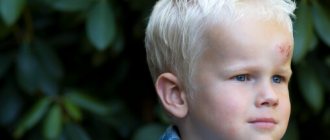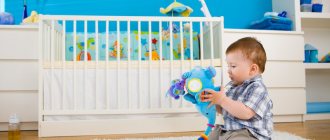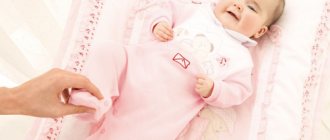How do you know when your baby is ready for complementary feeding?
A child is ready for complementary feeding at 6 months if:
- can hold his head for a long time
- can sit independently
- shows interest during meals and is inclined to eat when offered
At this age, breast milk or formula is still an important form of nutrition for the baby, and solid foods are a supplement. Not all 6-month-old babies are ready for solid foods. If the child doesn't show interest, parents can wait a few weeks and try again.
Puree
If your child is not bothered by frequent regurgitation, there are no problems with weight and development, one-component purees can also be the first complementary food. To begin, offer your child a scraped apple. Take an apple, peel it and scrape out the pulp with a teaspoon. In the same way, you can introduce your child to banana, pear, apricot, and after all these fruits are introduced into complementary foods and there are no allergies, you can mix the flavors.
You can also add vegetable purees from broccoli, pumpkin, and zucchini. You can prepare it yourself, or you can buy ready-made puree in jars.
Baby feeding pattern at 6 months
There is no “correct” feeding plan for a 6 month old, but parents should plan to gradually increase the amount of solids babies are introduced to. There is no need to force your child to eat solid foods or limit new foods if the child indicates that he wants more.
To start, you can give your baby 1-2 tablespoons of iron-fortified cereals or fruit or vegetable purees per feeding, gradually increasing the amount.
The mother can provide solid food as a supplement each time she breastfeeds or gives formula.
At 6 months, the baby is given solid food only once a day. After the child gets used to solid foods, the frequency can be increased to two and then three times a day. Regardless of eating habits, babies need a variety of solid foods. Most children will need to be introduced to new foods several times before they grow to like them.
At this age, it is quite acceptable for a child to play with food, as it is a way to explore new things.
Breast milk or formula remains the most important food at 6 months of age. The easiest way to make sure your baby is eating enough is to breastfeed or formula feed him on demand when he shows signs of hunger.
Adult drinks
Grandmother's compotes and mother's fruit drinks and rosehip infusions for treating colds are allowed after a year. One-year-old children can drink mineral waters labeled “table water” (not medicinal) and always without gas (“Essentuki No. 70”, “Essentuki No. 20”, “Borjomi Light”, “Springs of Borjomi”, “Selivanovskaya”, “Holy Source” etc.). From one and a half years old, a child can even be given cocoa with milk . Various instant chocolate drinks with vitamins such as Nesquika are suitable for children only after 3 years. But keep in mind that they contain vanillin, which in some cases causes allergies. As for strong tea, natural coffee and carbonated drinks, they are prohibited for children.
Research supports the importance of on-demand nutrition
The study found better academic achievement among children who were fed on demand. However, the mothers of these children slept less and had poor overall health. As a rule, children should be breastfed 3 to 5 times a day, and sometimes more. However, babies vary greatly and can eat up to eight times in 24 hours. While some babies sleep through the night at 6 months, others are still waking up or wanting to eat.
What should a 6 month old baby drink?
Babies do not need juices at 6 months. Extra calories can reduce a child's appetite, and sugar can damage a child's developing teeth. Soda and other drinks are harmful to children's health.
Babies can drink water starting at 6 months or when complementary foods are introduced.
At around 6 months, some babies move from three or four naps to two. The baby may take a nap in the middle of the morning and in the middle of the afternoon. At this age, most children need 12-15 hours of sleep per day, and naps usually last 1-3 hours. Some babies fall asleep while breastfeeding. Others fall asleep on their own.
Children may be hungry after waking up from a long nap. This may be a good time to introduce solids after formula or breast milk.
Children should never eat food unattended and should not be given solid foods in bed.
What, how and in what quantities should I drink?
It makes no sense to force a healthy child to drink water. That is, if the doctor told you that the baby must drink 100 ml of water a day, but he refuses, then this is not a tragedy at all - it’s up to you to offer it, and whether to drink or not to drink - the child will decide for himself.
It is generally accepted recommendations that a child should drink boiled water. You should know that boiled water has nothing to do with human biological needs, since no normal living creature drinks boiled water.
Boiling aims to destroy pathogenic microorganisms, but at the same time, salts dissolved in water precipitate, which the child’s body also needs.
Thus, it is necessary to kill two birds with one stone - to ensure the purity of the water and at the same time preserve its natural composition. Solving the problem is not difficult, and this can be done in the following ways:
- Bring water from a spring or artesian well: a three-liter jar, which will stand in the refrigerator closed, will be enough for 1-2 months, and there will be some left over.
- Buy a bottle of mineral water of neutral taste (not Narzan, and not Borjomi, and not Mirgorodskaya, of course). If the water is carbonated, remove the gas (open, chat, stir, wait).
- If it is impossible to use these ways, you can ensure the purity and decent mineral composition of the liquid by preparing a raisin decoction. This is done as follows: raisins, well washed in cold water, are brewed like tea, or steamed in a thermos - for 1 tablespoon of raisins - 1 glass of boiling water. After an hour, the drink is brought to the desired temperature, and drink to your health.
The amount of fluid your baby needs is determined by how much fluid he loses. The main ways the body loses water are humidification of inhaled air and sweating.
The warmer and drier the room and the warmer the child is dressed, the more fluid he loses, the more important it is for him to drink.
When the air temperature in the room does not exceed 20 °C, it is very difficult to get a baby to drink. At 24 °C, the need for water is approximately 30 ml per 1 kg of weight per day, i.e. for a newborn about 100 ml.
It goes without saying that it is necessary to give the baby water between feedings if he wakes up, for example, an hour after eating. Believe me, a healthy baby who does not have enough fluid will never sleep peacefully from feeding to feeding. With a lack of fluid, intestinal juices become thick and cannot cope with their responsibilities for processing food. And the child has a tummy ache. Therefore, doctors have come up with a wonderful way to treat abdominal pain - they prescribe dill water. The child was not given anything to drink, and he cried. Then they started giving dill water and everything went away. Only dill has nothing to do with it. You can also drink parsley, celery and salad water with the same success. The main thing is different: if it is not possible to avoid fluid loss - it is very hot - providing the child with water in addition to breast milk should be given priority attention.
Unlike milk formulas, whose temperature should be 36-37 °C, water can be cooler - 26-30 °C in the first one or two months of life and about 20 °C for older children.
In any case, the problem of drinking is secondary. It simply does not exist if the room is provided with the proper temperature (18-19 ° C) and air humidity (50-70%). That is why the desire or reluctance to drink water is an extremely convenient criterion for answering the question: is there overheating or not. He’s healthy, but he drinks greedily, which means he’s overheated. Take action quickly. If he refuses to drink, that’s fine (I remind you: it’s our job to offer).
author Komarovsky E.O. book Child's health and the common sense of his relatives published 02/26/2010 15:17
What to do if he drinks a lot?
If the total amount drunk exceeds the recommended norms, it is worth determining the reason why this happens. This may be a sign of illness, but usually it is a reaction to an uncomfortable microclimate in the room where the child is most of the time.
It often happens that the room is hot and the air is dry . The child's body reacts to this with increased water consumption. Dehydration can be determined by dry mucous membranes, redness of the skin, and infrequent urination.
It is believed that in the room where children live, it is necessary to maintain the temperature within 18-22˚C and the humidity at least 50-70%.
Read more about why your child drinks a lot of water here.
Dangerous symptoms
To understand that your baby is showing signs of dehydration, you need to carefully monitor his condition. The following should be on your guard:
- the baby's diaper remains dry for more than 6 - 8 hours;
- too restless state;
- he is capricious and cries a lot, but no tears come out;
- urine that is too dark and rich in color;
- pale and dry skin;
- dry lips;
- the baby drinks very greedily;
- an older child suddenly began to get tired quickly and severely, show signs of absent-mindedness, problems with short-term memory, nausea and weakness appeared.
Parents should definitely offer their children something to drink, especially babies who cannot yet ask for it themselves.
Causes of thirst at night
The reason may be that the child ate something thirsty before going to bed , such as spicy, salty or sweet food.
It is important to monitor your children’s diet and not feed them food in the evening that will make you thirsty later.
Another reason why a baby drinks at night is because he is hot. In this case, you need to get into the habit of ventilating the room before putting him to bed.
If this happens frequently, the cause is most likely a disease . To determine the child's health status, an examination should be performed.
This article will tell you more about the causes of night thirst in children.
Which one is best?
Babies' bodies are sensitive to what they consume , and water is of great importance for their health and development. Older children are no longer so susceptible to water deficiencies, but they also need to be given only high-quality, clean water.
Baby
You definitely shouldn’t give raw tap water; it may contain pathogenic microorganisms that can cause intestinal diseases.
To avoid infection, you need to at least boil the water and cool it . Water from natural sources, for example, from springs and wells, is clean, but can be dangerous for the same reason.
In addition, it may contain:
- pesticides,
- nitrates,
- heavy metals,
- plastic,
- other chemicals.
They are harmful to adults, and even more so to children’s bodies.
Mineral water, even slightly mineralized, is also not suitable for use by young children. The salts dissolved in it will create excessive stress on the kidneys and increase diuresis.
It is best to give children bottled water . It is completely pure, free of pathogens and minerals.
You can buy it in grocery stores and supermarkets; the bottles must have special markings indicating that the product is intended for babies.
This water does not need to be boiled, but should be stored in the refrigerator for a short time. Before use, be sure to warm up to body temperature.
For younger students
Schoolchildren can be given water that has been purified in household filters to remove impurities , mineral elements and bacteria.
You can use mineral, but with a minimum content of salts, without gas and silver ions, neutral acidity.
For older students
Children of this age can drink almost any water (preferably purified through filters) , plain or mineral, but one must take into account their health status and diseases for which different mineral water may be beneficial or, on the contrary, contraindicated.
How much fluid should a child drink?
The amount of water that should enter a child’s body depends on his age. Young children drink more than schoolchildren and teenagers. With age, the body's need for water decreases.
Up to a year
For normal and coordinated functioning of systems and organs and good health, the baby should receive from 120 to 150 ml per day for each kg of his weight . This includes water for preparing the mixture, various juices and clean water, the latter’s share should be approximately 1/3.
If the baby drinks less, this can lead to dehydration, especially on a dry, hot day; if more, it can lead to impaired kidney function.
Read more here.
Younger and older, teenager
For primary schoolchildren, the daily water requirement is almost 2 liters. Moreover, it is believed that boys need to drink 10% more than girls.
The norm for teenagers and high school students is almost the same as for adults . Calculating the volume is very simple: for each kg of weight there should be 30 ml.
These are just approximate indicators; in fact, the volume depends on the lifestyle that the child leads and his activity. If he moves a lot, plays sports, his body needs more.
This article will tell you how much water a child should drink per day.
How to train?
You need to start teaching drinking when your baby:
- in a good mood,
- funny,
- active,
- moves a lot.
You need to offer water as often as possible, even if the child refuses at first.
Children willingly repeat what the adults around them do, so the easiest way to show a child that drinking is important is by example . A mug with water should be in a visible place and always accessible to the baby.
This publication will tell you why a child does not drink water. Read about how to teach your baby to drink water in this article, and whether you should force your baby to drink water in this article.


